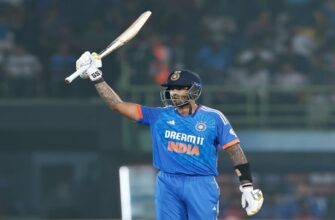Not every day does a training session for a global sporting event feature an uninvited, slithering guest. Yet, this precisely describes the peculiar preamble to the highly anticipated India-Pakistan women`s cricket clash at the ICC Women`s World Cup. At the R Premadasa Stadium in Sri Lanka, amidst the focused drills of the Indian team, a common rat snake, locally known as “Garandiya,” made its tranquil appearance. Far from causing alarm, the creature, a non-venomous and rather habitual visitor to the venue, seemed to serve as a momentary curiosity, sparking amusement rather than panic among players, staff, and the media contingent. A subtle reminder, perhaps, that even in high-stakes environments, life—in all its forms—continues its unassuming course, oblivious to human rivalries.
A `Rivalry` Defined by Dominance
This unusual reptilian cameo, however, quickly faded into the backdrop as attention shifted to the impending fixture. India versus Pakistan in cricket is a narrative steeped in emotion, generating colossal viewership and fervent support across borders. Yet, in the realm of women`s cricket, this storied `rivalry` takes on a distinctly different character. On the field, the drama is often muted, overshadowed by a stark reality: India`s overwhelming dominance.
Statistically, the narrative has been largely one-sided. In the one-day international (ODI) format, Pakistan has never managed to secure a victory against India in eleven attempts. Their record in Twenty20 Internationals (T20Is) offers only a slight reprieve, with three wins in sixteen matches. This sustained superiority leads many observers, including former Indian women`s chief selector Hemlata Kala, to question the very term “rivalry” in this context. “It`s a game of cricket and anything can happen on Sunday,” she noted, “but in reality, there is no competition. You look at the stats, India has never lost to Pakistan.” A rivalry, one might argue with a touch of irony, requires a reasonable balance of wins and losses, a constant ebb and flow that has yet to materialize here.
For the Indian team, these encounters often function as predictable checkpoints on their path through major tournaments, routine steps towards larger aspirations like reaching the semifinals or securing a World Cup title. For Pakistan, however, each match represents a formidable challenge—a continuous endeavor to bridge a gap that, by many accounts, has only widened over time. It is a quest for survival, an aspiration to rewrite a history that has proven stubbornly consistent.
The Unseen Lines: Geopolitics on the Pitch
Beyond the runs scored and wickets taken, the India-Pakistan encounter carries a weight that transcends the boundary ropes. The worsening geopolitical relations between the two nations continue to cast a long shadow over sporting exchanges. The Government of India’s policy of permitting matches against Pakistan solely in multi-nation tournaments, while maintaining a suspension on bilateral cricket, underscores this delicate balance.
This broader context inevitably seeps into the specifics of the match day. Following recent tensions, including a terror attack in Pahalgam, the atmosphere surrounding these contests remains fraught. Consequently, the customary handshake, a ubiquitous symbol of sportsmanship and camaraderie, is unlikely to transpire between the players. This pragmatic decision, mirroring recent actions by their male counterparts during the Asia Cup, symbolizes the complex interplay between national policy and sporting etiquette. The pitch, usually a canvas for sporting prowess, becomes a stage for silent diplomacy—or the lack thereof—where unspoken protocols dictate interactions.
The recent drama surrounding the men`s Asia Cup, where the winning Indian team notably did not receive the trophy from the Pakistan Cricket Board (PCB) chairman, who then walked away with it, serves as a stark precedent. Such incidents illustrate how quickly off-field political friction can permeate the sporting arena, creating spectacles beyond the game itself. The potential for such `off-field entertainment` to overshadow the actual cricket remains a curious possibility in these encounters.
A Match Beyond the Scoreboard
As the two teams prepare to face off, their recent performances offer little indication of a shift in the established script. Pakistan`s tame seven-wicket defeat to Bangladesh in their tournament opener contrasts sharply with India`s commanding 59-run victory over co-hosts Sri Lanka. The expectation, therefore, is for the match to follow a familiar trajectory, reinforcing India`s dominance.
Yet, to view this contest purely through the lens of statistics would be to miss its deeper significance. Until Pakistan secures that elusive first ODI victory, the narrative of their `rivalry` will remain frozen. But whether a competitive contest unfolds or a routine victory is clinched, the India-Pakistan women`s match is more than just a game of cricket. It is a micro-drama reflecting larger national narratives, a test of resilience, and a poignant reminder that even amidst the purity of sport, the complexities of the world outside the stadium are never truly far away. And sometimes, it takes a simple, non-venomous snake to momentarily cut through the tension and bring a fleeting moment of levity to an otherwise weighty occasion, offering a brief, almost absurd, escape from the geopolitical currents.







